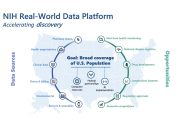
New York City may be considered the Wuhan virus’s current epicenter, with more than 57,159 people testing positive as of Friday morning. But the disease’s mortality epicenter just may be New Orleans, with its death rate being seven times the Big Apple’s. (In fact, the disparity may be even greater, unless The Big Easy is lying about its rate the way NYC is alleged to be doing.)
One possible reason is the Louisiana city’s high rate of obesity, a condition itself associated with higher incidences of many underlying medical conditions.
“‘We’re just sicker,’ said Rebekah Gee, who until January was the Health Secretary for Louisiana and now heads up Louisiana State University’s healthcare services division,” reports Reuters. “‘We already had tremendous healthcare disparities before this pandemic — one can only imagine they are being amplified now.’”
(One can perhaps only imagine because, as I’ve been lamenting, detailed data on the main groups affected by the virus is, interestingly, not being prominently disseminated to the public.)
New Orleans has emerged as yet another virus hot spot, do note, with its residents suffering more than 270 deaths as of Thursday.
This is unsurprising since its “residents suffer from obesity, diabetes and hypertension at rates higher than the national average, conditions that doctors and public health officials say can make patients more vulnerable to COVID-19,” writes Reuters.
“Some 97% of those killed by COVID-19 in Louisiana had a preexisting condition, according to the state health department. Diabetes was seen in 40% of the deaths, obesity in 25%, chronic kidney disease in 23% and cardiac problems in 21%,” the site continues.
This accords with data from Italy, mind you, which showed that more than 99 percent of the deceased had pre-existing conditions.
There are also other possible factors in New Orleans’ high Wuhan virus mortality rate, “ranging from access to healthcare and hospital quality, to the prevalence of other conditions including lung disease, health officials say,” Reuters further informs.
Consider here that New Orleans’ smoking rate is almost 20 percent, vs. NYC’s 13.9 percent.
Reuters also tells us that they’re seeing a family connection as well, with virus-stricken parents and children ending up in the intensive care unit — all afflicted with the same underlying conditions.
Unfortunately, lying conditions may also exist, making it hard to find comprehensive data on the disease or trust what’s related. Just consider American Thinker’s claim today that NYC “is lying about Chinese virus death rates.”
According to the site, the death of anyone in the city “who dies who tests positive for COVID-19 is counted as a coronavirus death. This is the case even if the coronavirus failed to play a significant role in the person’s passing or illness.”
“This calculus violates established scientific standards,” American Thinker avers.
Moreover, while officials are providing age- and underlying-condition-related data, more should be known. For example:
• As I asked a week ago, what percentage of Wuhan virus deaths is accounted for by vagrants? It could be significant because this population is highly vulnerable to disease, having weakened immune systems and great pathogen exposure.
• What is the deceased’s racial breakdown? Note that since black Americans have our nation’s highest obesity rate (48.1 percent) — and since 60.2 percent of New Orleanians are black vs. only 24.27 of NYC dwellers — this would help explain not only the southern city’s greater obesity rate, but also likely indicates that black Americans may be more affected by the virus. Of course, if this is reality and is revealed, we can expect the usual “institutionalized racism” accusations as explanation.
In addition, the average age of the deceased (it was 79.5 in Italy, the last I heard) and the percent with underlying conditions should be emphasized.
This matters because creating good policy rests on having good data. We may realize, for instance, that locking down most of the economy is wholly unnecessary if there are only a few highly imperiled groups. It’s better then to focus resources and attention on those groups. Moreover, such knowledge would help reduce the panic.
Why isn’t such data readily presented? There may be the concern, of course, that people won’t be vigilant unless sufficiently scared (there can be darker motives behind frightening people, too). Yet also note that many in this identity politics time are reluctant to talk about racial and ethnic disparities — unless doing so serves a leftist agenda.
The powers that be may also want everyone equally invested in the Wuhan virus situation and, therefore, may seek to portray it as an equal opportunity afflicter. We’ve seen this before, too.
It was sometimes said during the AIDS “crisis’s” early years that affected were the “three h’s”: homosexuals (high risk sexual behaviors), hemophiliacs (infection via transfusions), and heroin users (sharing dirty needles). Yet it seemed as if authorities often downplayed these associations and portrayed it as everyone’s problem.
Of course, the Wuhan virus should be everyone’s problem — as the flu (61,000 deaths during the 2017-18 season) should be — in that we should be hygienic and prudent so as to protect the vulnerable. Deception is also everyone’s problem, however.
We may learn this the hard way, too, if bad and unnecessary policy thrusts us into a great depression — and darkness beyond.
Photo: oonal/iStock/Getty Images Plus
Correction: As originally published, this article erroneously stated that “only 42.67 percent of NYC dwellers” are black, a mistake that occurred by inadvertently looking at a wrong column of data. The correct percentage is 24.27. We apologize for the error.
Selwyn Duke (@SelwynDuke) has written for The New American for more than a decade. He has also written for The Hill, Observer, The American Conservative, WorldNetDaily, American Thinker, and many other print and online publications. In addition, he has contributed to college textbooks published by Gale-Cengage Learning, has appeared on television, and is a frequent guest on radio.





